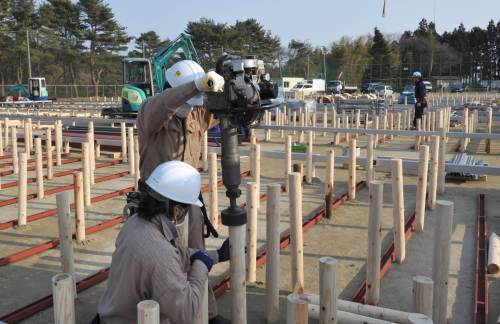World Bank: Japan may need 5 years to rebuild from devastating quake, tsunami
SINGAPORE (AP) ― Japan may need five years to rebuild from the catastrophic earthquake and tsunami that has caused up to $235 billion of damage, the World Bank said Monday.
The March 11 disaster ― which killed more than 18,000 people and ravaged northeastern Japan ― will likely shave up to 0.5 percentage point from the country’s economic growth this year, the bank said in a report. The impact will be concentrated in the first half of the year, it said.
“Damage to housing and infrastructure has been unprecedented,” the World Bank said. “Growth should pick up though in subsequent quarters as reconstruction efforts, which could last five years, accelerate.”
The bank cited damage estimates between $123 billion and $235 billion, and cost to private insurers of between $14 billion and $33 billion. It said the government will spend $12 billion on reconstruction in the current national budget and “much more” in the next one.
It said a crippled nuclear power station in the northeast that authorities are racing to regain control of is an unfolding situation that poses uncertainties and challenges. Traces of radiation first detected in spinach and milk from farms near the nuclear plant are turning up farther away in tap water, rain and even dust. In all cases, the government said the radiation levels were too small to pose an immediate risk to health.
SINGAPORE (AP) ― Japan may need five years to rebuild from the catastrophic earthquake and tsunami that has caused up to $235 billion of damage, the World Bank said Monday.
The March 11 disaster ― which killed more than 18,000 people and ravaged northeastern Japan ― will likely shave up to 0.5 percentage point from the country’s economic growth this year, the bank said in a report. The impact will be concentrated in the first half of the year, it said.
“Damage to housing and infrastructure has been unprecedented,” the World Bank said. “Growth should pick up though in subsequent quarters as reconstruction efforts, which could last five years, accelerate.”
The bank cited damage estimates between $123 billion and $235 billion, and cost to private insurers of between $14 billion and $33 billion. It said the government will spend $12 billion on reconstruction in the current national budget and “much more” in the next one.
It said a crippled nuclear power station in the northeast that authorities are racing to regain control of is an unfolding situation that poses uncertainties and challenges. Traces of radiation first detected in spinach and milk from farms near the nuclear plant are turning up farther away in tap water, rain and even dust. In all cases, the government said the radiation levels were too small to pose an immediate risk to health.

A short-term drop in Japan’s consumer demand and manufacturing production will also hurt trade with regional neighbors, the bank said. South Korean electronics companies have seen the price of some memory chips from Japan rise 20 percent because of disrupted production, while Thai car exporters may run out of Japanese auto parts next month, it said.
“Disruption to production networks, especially in automotive and electronics industries, could continue to pose problems,” the bank said. “Japan is a major producer of parts, components and capital goods which supply East Asia’s production chains.”
Japan’s northeast, the epicenter of the disaster, is home to ports, steel mills, oil refineries, nuclear power plants and manufacturers of auto and electronics components. Many of those facilities have been damaged, while nationwide power shortages have severely crimped auto and electronics production.
The World Bank said in a separate report Monday that economic growth in developing East Asian countries will likely slow this year as central banks raise interest rates to battle inflation pressure from rising food and energy prices.
The bank expects developing East Asia, led by China, to expand 8.2 percent this year and 7.9 percent next year from 9.6 percent in 2010. China’s economy, the world’s second biggest, will likely grow 9 percent in 2011 from 10.3 percent in 2010, the bank said. It said the forecasts were calculated before the 9.0-magnitude earthquake and tsunami.
The bank said central bankers in the region have been slow to attack the threat of quickening inflation from higher commodity prices, and urged policymakers to ease emergency government spending programs implemented during 2009’s global economic recession.
“Tighter monetary policies, including higher policy rates, are needed across the region in varying degrees to pre-empt the recent rise in food and other prices from exacerbating inflation expectations,” the bank said. “At the same time, governments need to allow their discretionary fiscal stimulus packages to lapse.”
About 51 million people were lifted out of poverty ― those living on less than $2 per day ― in developing East Asia last year, lowering the region’s poverty rate to 27 percent, or about 500 million people, the bank said.
Developing East Asia includes China, Indonesia, Malaysia, the Philippines, Vietnam, Thailand, Cambodia, Fiji, Laos, Mongolia and Papua New Guinea.







![[KH Explains] How should Korea adjust its trade defenses against Chinese EVs?](http://res.heraldm.com/phpwas/restmb_idxmake.php?idx=644&simg=/content/image/2024/04/15/20240415050562_0.jpg&u=20240415144419)










![[Today’s K-pop] Stray Kids to return soon: report](http://res.heraldm.com/phpwas/restmb_idxmake.php?idx=642&simg=/content/image/2024/04/16/20240416050713_0.jpg&u=)